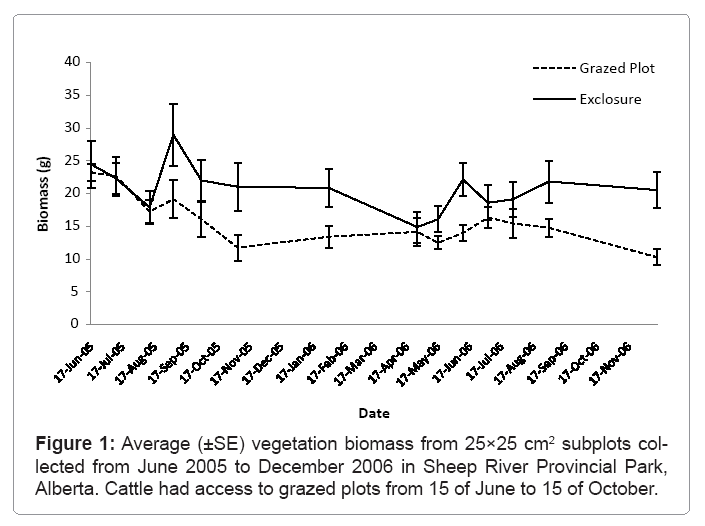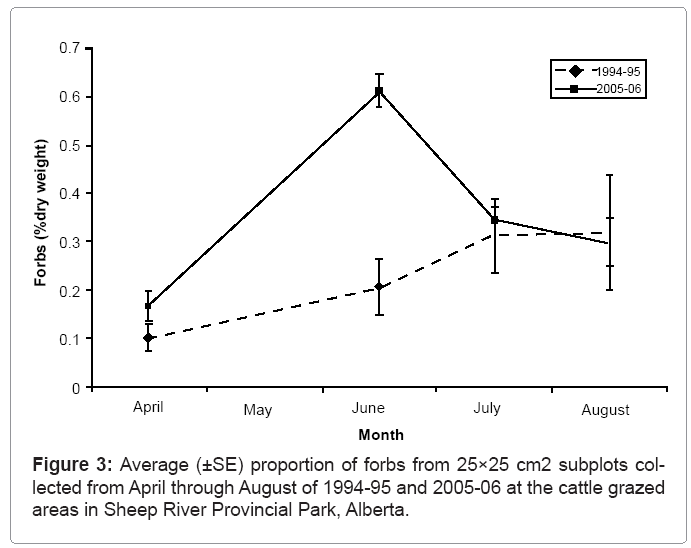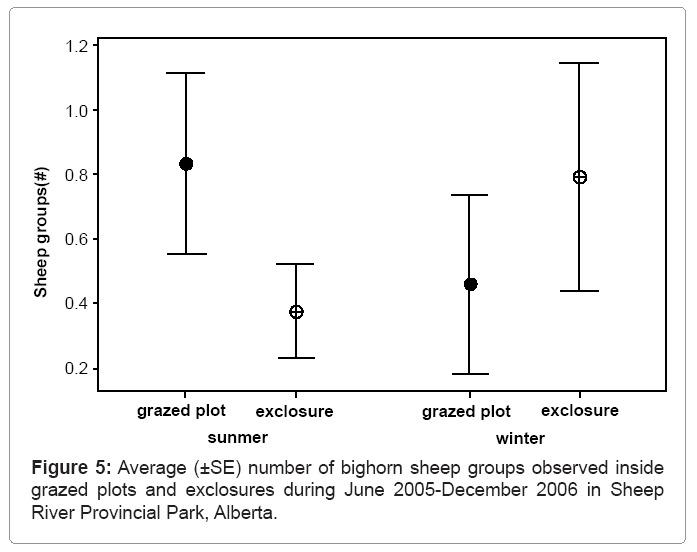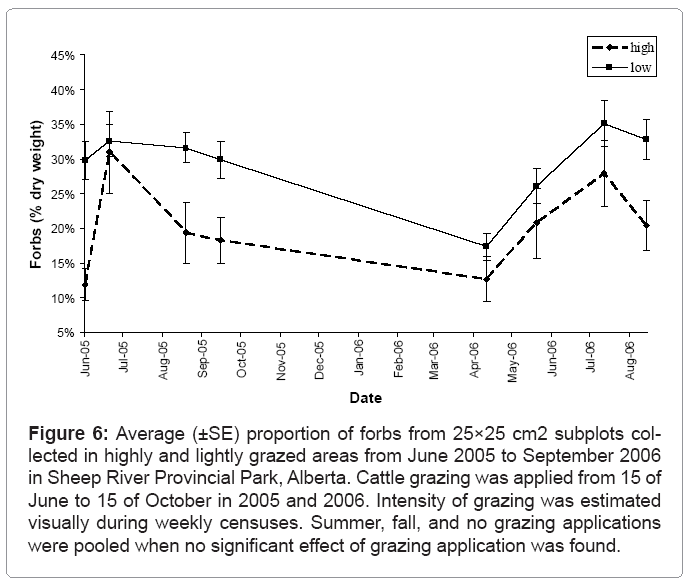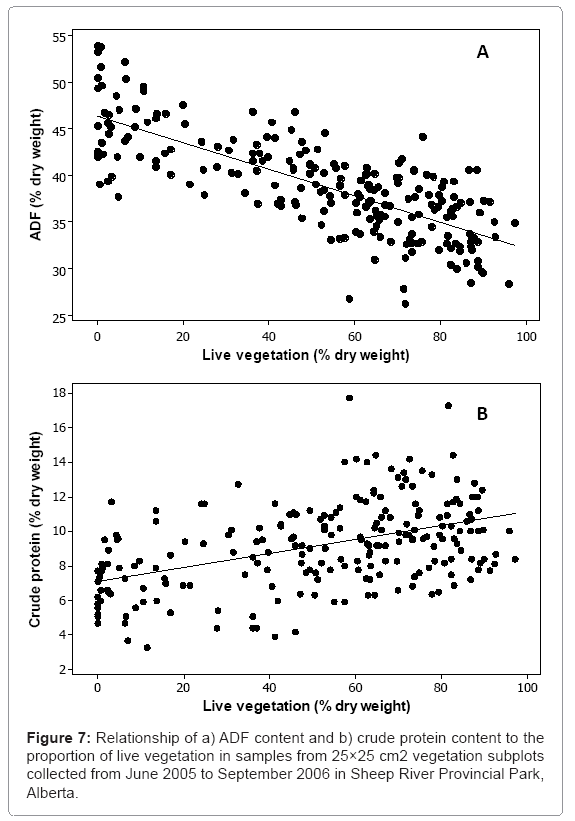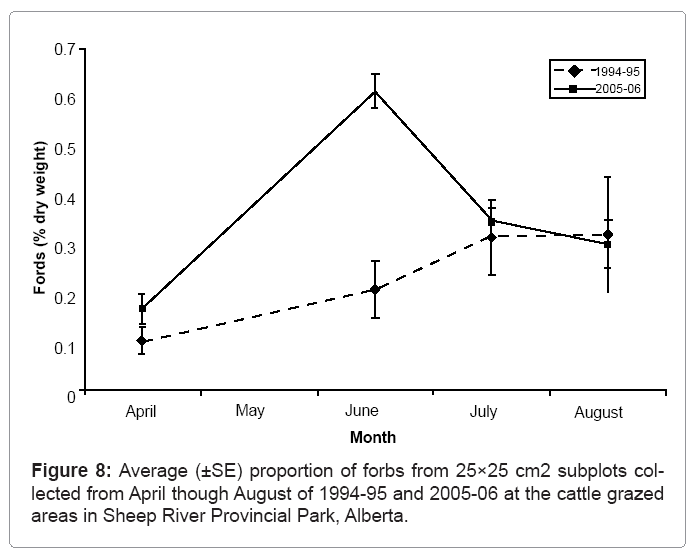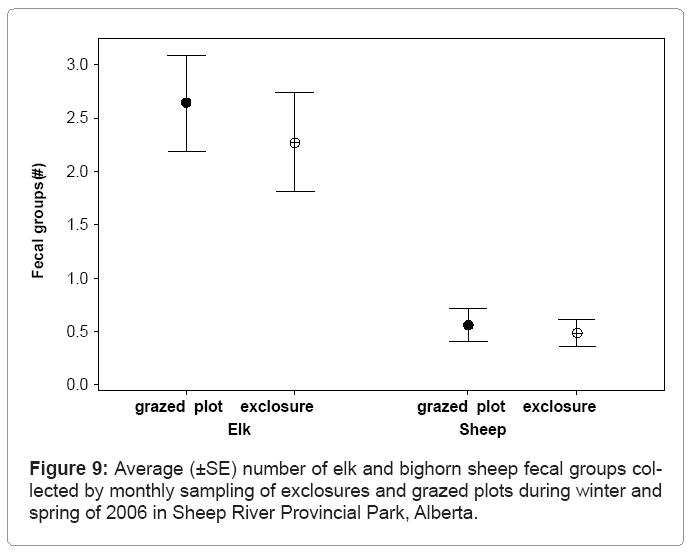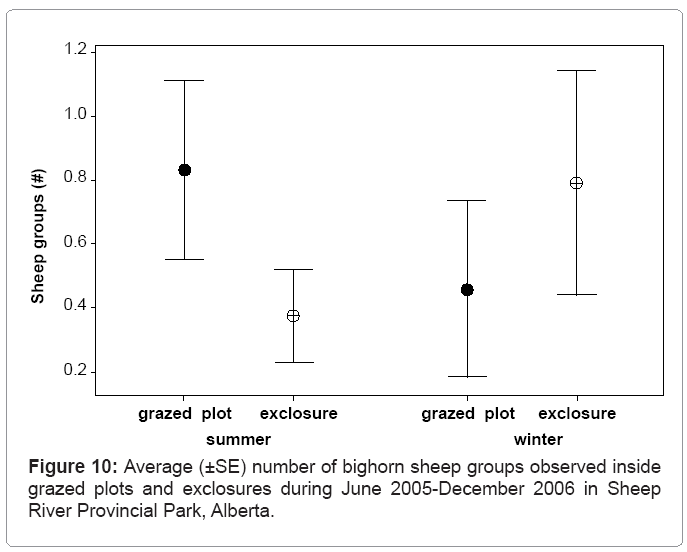Research Article Open Access
Differences in Vegetation and Native Ungulate use between Exclosures and Cattle Grazed Plots in Sheep River Provincial Park, Alberta
Natalia A. Brown* and Kathreen RuckstuhlDepartment of Biological Sciences, University of Calgary, 500 University Drive N.W. Calgary, AB T2N 1N4, Canada
- *Corresponding Author:
- Natalia A. Brown
Department of Biological Sciences
University of Calgary
500 University Drive N.W. Calgary
AB T2N 1N4, Canada
E-mail: brown.natalia@gmail.com
Received date: March 26, 2012; Accepted date: June 27, 2012; Published date: June 30, 2012
Citation: Brown NA, Ruckstuhl K (2012) Differences in Vegetation and Native Ungulate use between Exclosures and Cattle Grazed Plots in Sheep River Provincial Park, Alberta. J Ecosyst Ecogr 2:112. doi:10.4172/2157-7625.1000112
Copyright: © 2012 Brown NA, et al. This is an open-access article distributed under the terms of the Creative Commons Attribution License, which permits unrestricted use, distribution, and reproduction in any medium, provided the original author and and source are credited.
Visit for more related articles at Journal of Ecosystem & Ecography
Abstract
Cattle grazing can cause significant changes in quality and quantity of forage available to the wildlife. The effects of livestock on native ungulates are still unclear, and range from positive to negative depending on the season. The objectives of our study were to determine the impact of cattle grazing on the vegetation biomass and quality by comparing twenty-four livestock exclosures and corresponding grazed plots. Use of exclosures by bighorn sheep and elk were evaluated. Furthermore, we compared proportion of live vegetation and forbs from 1994-95 to 2005-06 to investigate long-term changes in the vegetation quality and biomass. As predicted, higher vegetation biomass and lower quality was found inside the exclosures during some of the months. The proportion of live vegetation found within an area was negatively correlated with acid detergent fiber (ADF) and positively correlated with crude protein indicating higher net energy and nutritional value. More forbs were found in the lightly grazed areas. Number of fecal groups did not differ significantly between exclosures and grazed plots. The number of sheep groups sighted was higher in grazed plots than exclosures during the summer, but not during the winter. The proportion of live vegetation and biomass did not change between 1994-95 and 2005-06, but more forbs were found in 2005-06 than before. Overall, most of our results corresponded well with previous studies. Care must be taken to ensure that nutritional requirements of native ungulates are met during the winter, as a decrease in vegetation biomass due to cattle grazing was more pronounced than the increase in quality during this time.
Keywords
Bighorn sheep; Biomass; Cattle; Digestibility; Exclosures; Livestock; Native ungulates; Protein; Vegetation
Introduction
The introduction of cattle can have a major influence on grassland communities affecting both producers and consumers [1-3], yet little is known to fully evaluate the extent of these impacts. Competition between ungulates and domestic cattle remains an important concern [4]. Despite considerable research on this topic, the results are mostly inconclusive or controversial [5].
It remains unclear whether the interactions between livestock and wildlife are mainly competitive or facilitative. On the one hand, negative impacts of cattle grazing on native ungulates are well recorded [1,2,6]. Some diet overlap was reported between cattle and elk [7], as well as between cattle and white-tailed deer (Ortega et al. 1997). White-tailed deer altered their winter diets on sites that were continuously grazed by cattle by selecting more herbs and less browse [8]. Native ungulates have consistently been reported to prefer ungrazed or rested areas within rest-rotation systems [9-12]. Intensive grazing reduced vegetation biomass [13] and decreased hiding cover formule deer [14]. Exclusion of cattle from an area decreased bare ground [15,16] and increased vegetation biomass and litter layer [3]. Furthermore, Yeo [17] reported that even with increased cattle management, health of sagebrush communities was still negatively affected by grazing.
On the other hand, previous research has shown that moderate cattle grazing can benefit native ungulates [18-20]. Holechek et al. [21] postulated that light to moderate grazing could improve vegetation survival and productivity under arid conditions. Light and heavy grazing reduced vegetation biomass in the fall, but elevated crude protein content and digestibility in fall and winter [22]. Clark et al. [23] reported that grazing by domestic sheep during late spring increased protein content of blue bunch wheatgrass (Agropyron spicatum) and improved winter forage for elk. Casasús et al. [3] also showed that moderate cattle grazing elevated protein content of forage. However, the increase in vegetation quality and nitrogen content was temporary and was lost during winter due to vegetation senescence [24].
The degree of competition between cattle and native ungulates consequently varies throughout the year. Early summer grazing minimally reduced foraging efficiency of mule deer and elk [25]. Alternatively, Thill and Martin [26] showed that cattle grazing during late fall decreased availability of deer forage, whereas moderate summer grazing did not have this effect. A study of interactions between African cattle and wild ungulates indicated that ungulates competed for food with cattle during the dry season, but improved the cattle’s diet quality during the rainy season (Odadi et al. 2011).
Good management plans can successfully increase both cattle production and ungulate density [18-20,27], as well as reduce damage to range during drought [28]. Because the effects of cattle grazing on native ungulates vary throughout the year, it is important to study changes in vegetation and ungulate range use on a month-to month basis.
We investigated seasonal differences in vegetation quality, mainly crude protein and acid detergent fibre (ADF), and biomass inside cattle exclosures and corresponding grazed plots. We also assessed changes in habitat use by bighorn sheep and other native ungulates in response to cattle grazing. Based on published research, we hypothesized that livestock would reduce vegetation quantity and increase vegetation quality. We predicted that this effect will be more pronounced if the grazing intensity is high. We also predicted that the all-season grazing application would have a stronger effect than spring or fall grazing alone.
If the current grazing intensity in the study area (Sheep River Provincial Park, Alberta, Canada) is detrimental to native ungulates, the decrease in forage availability should cause native ungulates to prefer exclosures over the grazed areas. However, cattle grazing may temporally improve vegetation quality by increasing protein concentration and decreasing ADF concentration (lower ADF is an indicator of higher digestibility). The increase in forage quality would cause wildlife to preferentially select the grazed areas. This effect may be lost in the winter, when forage availability is limited and vegetation quality decreases due to senescence. We also predicted that the total crude protein and digestible energy of forage would be higher inside exclosures due to the higher vegetation biomass. Additionally, we compared our results to the vegetation samples previously collected from the same areas in 1994-95. As the stocking rates have decreased in the South Sheep Allotment Area (Dr. Gates, personal communication) from 5176 cow-calf pairs in 1994 to 3400 cow-calf pairs in 2005 [29], we expected to see an increase in forage biomass, decrease in the proportion of live vegetation and change in proportion of live forbs, as indicated by previous research [22,23]. The effects of cattle grazing on the proportions of forbs vs. grasses are unclear. Dobkin et al. [15] reported less and Loeser et al. (2005) [30] reported more forb cover on the grazed vs. un-grazed areas, whereas Popolizio et al. [31] found little difference in the forb density resulting from cattle grazing. The direction of change may depend on grazing intensity, with moderate grazing removing enough competition from graminoids and increasing diversity [32], and intense grazing decreasing forb density and allowing only the strongest competitors to thrive.
Study Area
This study was conducted in Sheep River Provincial Park located near the Rocky Mountains in south-western Alberta (50°N and 114°W). The 18500 area is grazed by approximately 3400 cow-calf pairs from mid-May to mid-October [29]. The park was first subdivided into grazing allotments in 1917, which are currently leased to grazing [29]. Different sections of the park are separated by fences and cattle gates. Ranchers practice grazing rotation to homogenize grazing throughout the park, and cattle herds are moved between allotments several times during the grazing season (May-October).
The terrain is characterized by hills, canyons and flat meadows. Due to mild weather and strong winds, ungulates have snow-free forage access on hill slopes during most of the winter. Vegetation varies from grass and shrub land communities to aspen and coniferous forests. Some sections of the park are dominated by native vegetation such as rough fescue (Festuca scabrella), whereas others are overtaken by invasive species such as kentucky bluegrass (Poa pratensis) and timothy (Phleum pratense). Altitude varies from 1420 m to 1740 m [33]. The park is closed to vehicle access from December 1 to May 15 to protect native populations of elk, moose, bighorn sheep, mule deer, and whitetailed deer.
Methods
Exclosures
Exclosures are commonly used to study the effects of grazing on the vegetation [34]. In May 2005, 24 35 m × 35 m exclosures and 24 corresponding grazed plots of the same size were established in the Sheep River Provincial Park. Location of exclosures within a selected area was chosen randomly. Grazed plots were randomly positioned 35 m from the exclosures and clearly marked with wooden painted pegs. Each exclosure and grazed plot was assigned a unique Plot ID. Exclosures consisted of a 3-strand barbed wire fence with fence posts 3.5 meters apart and approximately 1 m in height. The timing of opening and closing of the fences (performed by taking down the barbed wire) controlled the cattle access to the exclosures. We assigned exclosures into three grazing applications as follows: “no grazing” exclosures were closed to cattle for the entire grazing season, “summer” exclosures were open from June to mid August and closed from August to October and “fall” exclosures were closed from June to mid August and open between August and October. The numbers of exclosures assigned to these treatments differed between the years as follows: “no grazing,” 2005 n=13, 2006 n=15; “summer grazing,” 2005 n=6, 2006 n=9; “fall grazing,” 2005 n=5, 2006 n=0. The number of the exclosures assigned to the treatments varied from year 1 to year 2 of the study because the application and timing of cattle grazing was not under our control. Although we tried our best to make sure that it was consistent throughout the study period, some of the assigned treatments were adjusted in order to better capture effects from the different grazing applications.
At the end of each grazing season (October) when cattle were removed, all exclosures were opened to allow free access of native ungulates by removal of barbed wire, although the fence posts remained in place.
Vegetation
The summer of 2005 was unusually wet and resulted in greater vegetation growth in the park (total precipitation 566 mm during May- July compared to a 5-year average of 285 mm; Environment Canada 2007)[35]. In contrast, the summer of 2006 involved a moderate rainfall, which resulted in lower production of vegetation (237 mm during May- July; Environment Canada 2007) [35].
We assessed plant biomass and quality through monthly vegetation clippings during the spring and summer (April to August) and semimonthly clippings during fall and winter (September to March), whenever the range was free of snow. Three subplots (25 cm × 25 cm) were randomly chosen for each exclosure and grazed plot and all vegetation was clipped at ground level. Samples were placed in paper bags, dried, and weighed. We then sorted selected samples into senescent and live vegetation, as well as into grasses and forbs. Selected samples (containing live and senescent vegetation, as well as grasses and forbs) were ground to 1 mm with a vegetation grinder. Samples were selected to give appropriate representation of each treatment throughout the study period. Bodycote Northwest Labs (Lethbridge, Alberta) analyzed dry matter for crude protein and acid detergent fibre (ADF). Prior to analysis, 5 samples were chosen randomly and divided in half to test the error in precision of lab analysis.
Crude protein is good indicator of digestible protein [36] and is calculated as 6.25 times the percentage of total nitrogen. Crude protein concentration was analyzed via the Leco combustion method (reference number 990.03 in AOAC® Official Methods of Analysis, AOAC International 2003)[37]. The vegetation samples were combusted in oxygen inside a Leco FP-528 combustion analyzer and nitrogen was released as a gas. Emitted gases were collected and homogenized. A gas sample was then passed through a detector, which measured gas thermal conductivity, used to calculate nitrogen concentration. We have calculated total crude protein as crude protein concentration multiplied by the biomass of the sample.
Acid Detergent Fibre is the amount of cellulose and lignin in the plant cell walls, which take the longest time to digest; so elevated ADF corresponds to decreased net energy. ADF concentration was analyzed using the reflux method (reference number 973.18 in AOAC® Official Methods of Analysis, AOAC International 2003)[37]. Vegetation samples were boiled in sulphuric acid detergent solution to separate insoluble ADF from soluble vegetation components. The residue remaining after extraction was dried at 100°C and weighed. The ADF concentration was then calculated as 100% × (residue mass/ sample mass).
Digestible energy content of the dry sample was estimated using crude protein and fibre concentration as DE = (1.91–(0.05×ADF)) + (0.0151×CP) + (0.00051×ADF×ADF) (Litchfield Analytical Services, Feed and Forage Analysis Definitions). Total digestible energy was calculated as digestible energy content × biomass of the sample.
A total of 1578 vegetation samples were collected during the first year of the study in May, June, July, August, September, October, November of 2005 and January, March and April of 2006. Samples were collected twice at different times in July of 2005. A total of 834 samples were collected during the second year of study in May, June, July, August, September and December of 2006. Under ideal circumstances, a total number of samples collected in the first year would have been 1584 and in the second year 864. As such, we collected 96.5% of samples in the first year and 99.6% of the samples in second year.
We used 458 samples from the first year and 405 samples from the second year to measure the mass of live vegetation and forbs. A total of 750 samples in the first year and 420 samples in the second year were used for ADF and crude protein analyses. Samples were selected to give appropriate representation of each treatment throughout the study period.
Data were analysed separately for the two years because the assignment of grazing applications (summer, fall and no grazing) differed from one year to the other. The first year (2005-2006) was divided into 5 seasons: pre-grazing (May 2005-mid June 2005), summer (mid June 2005-mid August 2005), fall (mid August 2005-mid October 2005), winter (mid October 2005-March 2006), and spring (April 2006-mid June 2006). The spring season was analyzed as a part of the first year to assess the effects of the previous summer’s grazing on the vegetation during the following spring. Consequently, the second year (2006) was divided into three seasons: summer (mid June 2006-mid August 2006), fall (mid August 2006-mid October 2006), and winter (mid October 2006-December 2006).
Not all areas in the park were grazed equally, as cattle spent more time in the meadows and less time on the hill slopes. To control this difference, we performed weekly visual estimates of grazing intensity in areas with experimental plots. Grazing intensity during the previous week was scored from 1 to 4 (1=no grazing signs, 2=some trampling and grazing signs, but little vegetation removed, 3 = medium grazing with vegetation removed down to 5-10 cm, 4=extensive grazing, with vegetation height below 5 cm). At the end of the grazing season (October) we estimated the average grazing intensity as either high (average score between 3 and 4) or light (average score between 1 and 2). Most of the exclosures and grazed plots in the hayfields and meadows were located in the highly grazed areas, whereas hill slopes and forests were lightly grazed.
Additionally, to evaluate long-term effects of grazing on vegetation, we used samples previously collected from eight locations during the springs and summers of 1994 and 1995 using the same techniques. All of these samples were collected from the areas that were grazed by cattle. (except for the east part of the HF which was not grazed by cattle prior to 1998). Biomass, proportion of live vegetation, and proportion of forbs in these samples were compared to the samples collected from the same locations during the springs and summers of 2005 and 2006.
Animal use of the exclosures
All fences were removed at the end of each cattle grazing period (October), so native ungulates had free access to all exclosures during winter and spring. During the summer ungulates could access exclosures because, unlike cattle, they could easily jump the fences. The native ungulates’ use of exclosures and grazed plots was evaluated by performing year-round weekly observations of exclosures and grazed plots. During these observations we recorded the presence of all sighted native ungulates inside the exclosures and grazed plots and their activity at that time (grazing, lying, etc).
During the winter and spring of 2006, we preformed monthly fecal pellet-group counts of all exclosures and grazed plots. Fecal transects were run from one side to the other side of the exclosures and grazed plots. Three fecal transects were run from one side to the other side of each exclosure and grazed plot and the total number of pellet groups was calculated. Transect direction was determined randomly; however all exclosures and plots were sampled in the same way during one sampling period. Fecal groups within 1 m on either side of a transect were identified to the species and counted. Only fecal groups of native ungulates were sampled. Care was taken to count only fresh fecal groups to avoid repeated counts.
Statistical Analysis
Vegetation
SAS version 6 (1989) [38] software was used to perform repeated measures mixed-model analysis and Minitab version 14 [39] software was used for all of the other statistical tests. Precision of lab analysis was tested with paired-sample t-tests that compared ADF and crude protein between split samples.
The averages of biomass, crude protein concentration and total crude protein, ADF, total digestible energy, mass of forbs and mass of live vegetation from the three vegetation samples from each exclosure and grazed plot were calculated and used for analysis. We analysed the pooled data from all three grazing applications (no grazing, summer and fall). Biomass was log-transformed to meet the assumptions of normality and homoscedasticity. Effects of grazing application, treatment (exclosure or grazed plot), season, date, and interactions of these factors on the biomass were analyzed using repeated measures mixed-model procedure. A mixed-model was also used to test the effect of grazing intensity (high/light), grazing application (summer, fall, no grazing), treatment, date, and interactions of these factors on the proportion of acid detergent fibre (ADF), crude protein concentration, total crude protein and total digestible energy. Additionally, we analyzed the effects of grazing intensity (high/light), grazing application, treatment, date, sample mass, and interactions of these factors on the masses of live vegetation and of forbs. Whenever significant interactions were found, we used contrasts tests to further investigate specific effects. Linear regression analysis was performed to compare the proportions of forbs and grasses to ADF and crude protein concentration. To analyze vegetation changes between 1994-95 and 2005-06, we used a repeated measures mixed-model to test for the effects of year and month on the biomass, proportion of live vegetation, and proportion of forbs.
Fecal data
Fecal count data were separated into two periods: February-May 2006 (4 repetitions) and December 2006 (3 repetitions). Average counts for each period and each exclosure were taken for sheep and elk. As there were only 6 sightings of moose fecal groups and one deer group, they were not considered for analysis. The average fecal group count was ln-transformed used to meet the assumptions of normality and homoscedasticity. We used a General Linear Model (GLM) to test for the effects of period, grazing application (summer, fall, no grazing), animal species (elk or sheep), plot ID (unique name assigned to each exclosure and grazed plot), and treatment type (exclosure or grazed plot) on the average number of fecal groups found per transect.
Ungulate use of exclosures and grazed plots
The average number of animal groups during two years in each exclosure and grazed plot was calculated. Because assumptions of normality could not be met, we used the non-parametric Wilcoxon Matched-Pairs Signed-Ranks test to test for the differences in animal counts between exclosures and grazed plots. A goodness of fit chisquare test was performed to investigate whether the animals grazed more often in the exclosures than in the grazed plots.
Results
Vegetation
Quality assurance tests of five samples showed that lab results differed by 0.62% for ADF analysis and by 1.00% for crude protein analysis. The results from split bags did not differ statistically for either ADF (t4 = 0.054, P = 0.960) or crude protein (t4 = 0.074, P = 0.945). During the first year, grazing application (F2, 43.9 = 2.52, P = 0.092) and treatment (F1, 43.8 = 3.80, P = 0.058) had almost significant effects on the vegetation biomass. Biomass varied significantly among dates (F7, 412 = 4.98, P<0.0001) and seasons (F4, 412 = 28.44, P<0.0001) and treatment effects varied among seasons (Interaction: F4, 412 = 5.43, P<0.001). The posteriori contrasts indicated significantly higher biomass in exclosures than grazed plots during the winter only (F1, 68.9 = 10.40, P = 0.002; Figure 1a). During the second year, biomass varied similarly among seasons (F2, 211 = 19.51, P<0.0001; Figure 1b) and exclosures had higher biomass than grazed plots (F1, 45.4 = 12.12, P = 0.001). Higher biomass was found in the “no grazing” plots than in “summer” plots (F1, 45.4 = 7.42, P = 0.009; Figure 1b). No significant interactions between factors were observed.
During both years, ADF concentration was not significantly higher in exclosures than grazed plots, except for June 2006 (F1, 97.9 = 13.56, P<0.001; Figure 2a). ADF concentration was significantly higher in areas of light grazing (Year 1: F1, 41.8 = 24.14, P<0.0001; Year 2: F1, 33.9 = 23.90, P<0.001) and varied with date (Year 1: F8, 16 1= 28.47, P<0.0001; Year 2: F4, 83.3 = 37.51, P<0.0001). Total digestible energy was significantly higher in the exclosures than grazed plots (Year1: F1,11.5 = -5.125, P = 0.044; Year2: F1,13.5 = 6.828, P = 0.021; Figure 2b) and varied with date (Year 1: F7,151.7 = 19.462, P<0.001; Year2: F5,111.8 = 6.350, P<0.001).
During the first year, crude protein concentration varied significantly with date (F8, 166 = 33.36, P<0.0001; Figure 3a) and grazing application (F2, 20.3 = 6.74, P = 0.006). Protein concentration was significantly higher in grazed plots than exclosures (F1, 20.3 = 4.61, P = 0.044) and grazing treatment interacted significantly with grazing application (F2, 20.3 = 3.47, P = 0.050) and grazing level (F1, 20.1 = 8.25, P = 0.009). Vegetation had higher protein concentration in grazed plots in highly grazed areas (F1, 20.4 = 15.40, P<0.001) and for the “fall” grazing application (F1, 20.9 = 12.41, P = 0.002; Figure 4). During the second year, crude protein concentration was significantly higher in the highly grazed areas (F1, 25 = 4.31, P = 0.048) and significantly affected by date (F4, 43.6 = 24.63, P<0.001; Figure 4). Significant interactions were found between treatment and grazing level (F1, 31.8 = 2.43, P = 0.1291) and treatment and date (F4, 43.4 = 3.49, P = 0.015). Contrasts indicated that protein concentration was higher, although not significantly, in grazed plots than exclosures in highly grazed areas (F1, 28.4 = 3.29, P = 0.080) and significantly higher in grazed plots than in exclosures on June 2006 (F1, 24.2 = 9.68, P = 0.005).
On the contrary, there was a non-significant trend towards higher total protein inside the exclosures especially in the second year (Year 1: F1, 11.7 = 1.594, P = 0.231; Year 2: F1, 13.6 = 4.132, P<0.062; Figure 3b). Total protein varied significantly between dates (Year 1: F7, 152.0 = 26.494, P<0.001; Year 2: F5, 112.3 = 7.624, P<0.001).
The mass of live vegetation during the first year varied significantly with date (F2, 86 = 88.66, P<0.0001; Figure 5) and total biomass of the sample (F1, 94.3 = 331.59, P<0.0001). During the second year, mass of live vegetation was higher in grazed plots than exclosures (F1, 44.9 = 5.12, P = 0.029), and was also affected by date (F2, 86 = 31.52, P<0.0001) and total biomass of the sample (F1, 89.9 = 152.86, P<0.0001). A significant interaction between treatment and date (F2, 85.3 = 5.41, P = 0.006) resulted because live vegetation mass was higher in the grazed plots than in exclosures on June 2006 (F1, 120 = 15.21, P<0.001).
During the first year, the mass of forbs differed significantly among the grazing applications (lowest for “fall” grazing application, followed by “summer”, then “no grazing” application) (F2, 52.6 = 3.72, P = 0.031). Forb mass was higher in the low grazed areas (F1, 52.3 = 7.18, P = 0.010; Figure 6). Mass of forbs was also affected by date (F4, 93.2 = 9.47, P<0.001; Figure 6), and total biomass of the sample (F1, 123 = 32.40, P<0.001). Date and grazing intensity had interacting effects (F4, 87.5 = 2.29, P = 0.066), because lightly grazed areas had more forbs during September 2005 (F1, 57.4 = 6.41, P = 0.014) and June 2005 (F1, 39.9 = 5.81, P = 0.021). During the second year forb mass was higher in lightly grazed areas (F1, 41.6 = 6.21, P = 0.017) and varied with date (F2, 53.4 = 4.34, P = 0.018; Figure 6) and total biomass of the sample (F1, 107 = 21.00, P<0.001).
Figure 6: Average (±SE) proportion of forbs from 25×25 cm2 subplots collected in highly and lightly grazed areas from June 2005 to September 2006 in Sheep River Provincial Park, Alberta. Cattle grazing was applied from 15 of June to 15 of October in 2005 and 2006. Intensity of grazing was estimated visually during weekly censuses. Summer, fall, and no grazing applications were pooled when no significant effect of grazing application was found.
The ADF concentration varied negatively (ADF=45.5-14.2 × live vegetation; T217 = -17.20 P<0.001, R-Sq (adj)=57.7%, Figure 7a), whereas the crude protein concentration varied positively with the percentage of live vegetation (CP = 5.68+4.73 × live vegetation; T217 = 7.50, P<0.001, R-Sq(adj) = 20.4%, Figure 7b). No significant relationship between proportion of forbs and ADF or protein concentration was detected (N = 217, T = -0.80, P = 0.425, R-Sq (adj) = 0.0%; N = 217 T = 0.71, P = 0.480, R-Sq (adj) = 0.0%). The proportion of live vegetation did not change significantly between 1994-95 and 2005-06 (F1, 15.4 = 1.51, P = 0.237), but it did vary significantly from month to month (F7, 40.4 = 68.41, P<0.001). Overall biomass of the sample showed similar trends (Year: F1, 15.3 = 0.83, P = 0.376), (Month: F7, 37.6 = 2.81, P = 0.019). Proportion of forbs increased significantly from 1994-95 (X¯ = 21.47% ± 3.07%) to 2005-06 (X¯ = 35.57% ± 3.39%; F1, 19.5 = 14.99, P = 0.001) and changed from month to month (F7, 24.3 = 14.85, P<0.001, Figure 8).
Fecal data
Number of fecal groups was significantly higher for elk than sheep (F1 = 66.26, P<0.001), and differed between the periods of collection (F1 = 4.72, P = 0.031), and the different plots (F1 = 2.99, P<0.001) (Figure 9). Neither grazing application (summer, fall, no grazing; F2 = 0.03, P = 0.971) nor treatment (exclosure, grazed plot; F1 = 1.73, P = 0.190) significantly affected fecal density.
Ungulate use of exclosures and grazed plots
A total of 60 sightings of bighorn sheep groups were recorded in 14 grazed plots and 12 exclosures. Only 13 sightings of other ungulates (elk, mule deer and white-tailed deer) were recorded, so we only used bighorn sheep data (Figure 10). During the summer, sheep groups were observed more often in the grazed plots than in the exclosures (W+ = 33.50, W- = 2.50, N = 8, P = 0.023). During the winter the difference between sheep groups in grazed plots and exclosures was not significant (W+ = 6.50, W- = 21.50, N = 7, P = 0.219). Animal activity also did not differ significantly between exclosures and grazed plots (χ2 = 1.164, P = 0.281, df = 1).
Discussion
Biomass
Not surprisingly exclosures contained more plant biomass than grazed plots, as Casasús et al. [3] and Ganskopp et al. [22] also reported. During both years, the difference between exclosures and grazed plots was highest during the winter, when the forage supply can be critical for native ungulates. During the second year, exclosures that were closed for the entire season had more biomass than exclosures that were open during the summer.
The effect of treatment and grazing application changed from near significant during the first year to significant during the second year. This increased effect could have arisen because vegetation biomass took more than one year to increase after reduction or removal of cattle grazing. The relatively heavy precipitation during the summer of the first year may also have offset the grazing impact by increasing vegetation growth in both exclosures and grazed plots. Vegetation biomass was indeed higher during the first than during the second summer. Additionally, biomass was highest during August of the first year and during October of the second year. This difference may also reflect contrasting precipitation patterns between the years.
Protein, ADF, and digestible energy
ADF concentration was higher in the exclosures located in lightly grazed areas during the early summer. Because high ADF indicates lower digestibility of the vegetation, cattle grazing appears to increase forage quality, although not significantly for most of the year. As expected, the biggest difference in ADF concentration between exclosures and grazed plots occurred during early summer, but not during late fall or winter. On the other hand, crude protein concentration was higher in the plots subjected to intense grazing even during fall and winter. These results do not correspond to the findings of Wambolt et al. [24] who argued that increase in protein due to cattle grazing becomes non-significant during the following winter. However, their experiment investigated the effect of spring grazing only, whereas we looked at summer and fall grazing, the effects of which may continue through the winter. Ganskopp et al. [22] similarly found that summer cattle grazing increased crude protein and digestibility of vegetation during fall and winter. It is possible that cattle grazing delayed maturation of forage which led to production of more immature and highly nutritious stages of vegetation [40].
We did not anticipate that the difference in crude protein concentration between grazed plots and exclosures would be significant only in exclosures open to grazing during the fall of the first year. We expected this difference to be greater between the exclosures that were closed for the entire season and the associated grazed plots. Closer examination of the data indicated that the grazed plots associated with “fall” exclosures had higher protein concentration than other grazed plots from the beginning of the study. The cause for this difference, however, remains an open question.
Although vegetation quality was higher in grazed plots, total amount of digestible energy and crude protein was higher inside the exclosures. This could be explained by the higher biomass inside the ungrazed areas that offset any gains in vegetation quality.
In general, livestock grazing increased forage quality, which is well supported by previous studies [3,22-24]. However, these patterns were irregular and changed between years. Biomass decreased substantially on the grazed plots, and total digestible energy was higher in the exclosures. It would be interesting to extend this study to see whether the differences in quality and biomass between exclosures and grazed plots accentuate over time, due to litter accumulation in the ungrazed areas.
Mass of live vegetation
Fibre content varied negatively, whereas crude protein content varied directly with the percentage of live vegetation, showing that new vegetation provides the most nutritional value to the ungulates. As expected, the amount of live vegetation was highest during summer and lowest during winter. Grazed plots had more live vegetation, but only during the second year, and mainly during June. Grazing during the previous year appeared to increase new growth and nutrition during the following early summer, possibly by increasing access to sunlight through the removal of old layers of vegetation. However, we expected that livestock grazing would affect the amount of live vegetation during the entire year, not just during the spring. Previous studies consistently found more litter inside exclosures, which would correspond to a lower proportion of live vegetation [41-43]. The proportion of live vegetation mass did not differ between 1994-95 and 2005-06. It is possible that the decrease in stocking rates was offset by the increase in mass of cows and calves that has been occurring over the decade.
Forbs
The dry biomass of forbs did not differ between grazed plots and exclosures in contrast to the biomass of live vegetation. This suggests that it was mainly the biomass of live grasses that increased in grazed plots. Historically, it has been unclear whether the livestock grazing increases or decreases the proportions of forbs and grasses and the effects of grazing on community composition vary with grazing intensity. Dobkin et al. [15] reported higher forb cover inside long-term exclosures, whereas Loeser et al. (2005) [30] found fewer forbs inside cattle exclosures, and Popolizio et al. [31] showed that forb cover did not vary much with long-term grazing. Removal of grazing may also change vegetation composition more slowly than would be detected by a two-year study [44].
Forbs were more abundant in the lightly grazed areas. However, we cannot exclude the effect of other factors in addition to cattle grazing, such as elevation and hill steepness, as cattle preferred to graze on low meadows with close access to water [45]. Proportionally fewer forbs were found during 1994-95 than in 2005-06. Unfortunately, we cannot separate the effect of the decrease in long-term grazing from shifts in vegetation composition due to other factors. It is possible that high rainfall during the summer of the 2005 caused an increase in forb production, resulting in the observed difference. Future studies should consider vegetation composition in more detail and differentiate between plant species. Comparisons of long-term changes inside and outside the exclosures are also needed to separate the effects of cattle grazing from other factors.
Ungulate use of exclosures and grazed plots
Based on fecal group counts wild ungulates used grazed plots and exclosures equally during the winter. This result was unexpected, as previous studies reported that elk preferred ungrazed areas to the grazed sites [11,46-48]. On the other hand, Halstead et al. [49] found minimal impacts of cattle grazing on elk distribution. Lack of visible differences in this experiment might also be attributed to the size of the exclosures. Fecal counts were performed during the winter when barbed wire fences were removed, so exclosures themselves were unlikely to deter animals from ungrazed patches. However, 35×35 m exclosures might have been too small to affect sheep and elk. Gross and Knight [50] argued that an exclosure must be at least 4 hectares to observe changes in elk use due to vegetation differences.
Visual counts indicated that sheep used grazed plots more often than exclosures during the summer, but not during the winter. This result could be due to the barbed wire around some exclosures during summer that might have deterred sheep. Sheep may have also selected grazed plots during early summer because of the higher availability of live vegetation. Bighorn ewes have previously been shown to forage mainly on new vegetation during the spring, because of its higher nutritional value [9]. During the winter period, when barbed wire was down, sheep use of exclosures did not differ, so sheep either did not preferred grazed over ungrazed areas, or exclosures were too small to show this preference.
This research was one of the few that involved a large number of exclosures, and therefore had a bigger sample size. Most of the previous vegetation studies did not use more than 5 exclosures [3,15,41,51]. Having 24 plots throughout the park located in different habitats (hill slopes, meadows, and forests) allowed us to be more confident in our results. Furthermore, month-to-month collection of the vegetation helped us to look at the seasonal dynamics and revealed the critical times in forage availability. The majority of the previous vegetation research did not address the continuous effects of grazing throughout different times of the year [6,15,52].
Conclusion
As predicted, the livestock grazing caused some increase in vegetation quality and decreased the amount of forage and digestible energy. The reduction in forage availability was most significant during winter. From a management perspective the increase in digestibility might not make up for the decrease in the forage quantity, total protein, and digestible energy during the periods of forage shortage. It is important to consider the impacts of grazing throughout different seasons and not just overall annual changes to recognize most critical periods for native ungulates. This study shows that the extent of impacts of cattle on forage supplies can change through the year. Although grazing induces increase in quality, sheep may still experience a nutrient deficiency. Even though grazed plots had higher proportion of live vegetation during June 2006, more of the total biomass and digestible energy was found in the exclosures during the same month.
Long-term cattle grazing may alter vegetation composition. We found more forbs now than 10 years ago. More detailed studies are needed to recognize whether this change resulted from cattle grazing or other factors (i.e. rainfall). Moderate livestock grazing has been previously associated with greater vegetation diversity than either lack of grazing or high stocking levels [32]. However, if vegetation composition changes, we need to ensure that it is not driven by the introduction of invasive species. Native ungulates, such as elk and bighorn sheep, did not prefer either grazed or ungrazed areas when fences were removed. Either the ungulates may not have been constrained by forage availability or the larger cattle exclosures are necessary to observe this effect.
Acknowledgements
Authors would like to thank B. Curry, T. Whitehead, C. Mueller, R. Schneeberger, I. Glanzmann, B. Fairbanks, J. Preslovski, G. Pelchat, K. Jones, I. Chaikine, B. Hoar, J. Guevara, J. Purcell and D. Brown for help with this project. This study was made possible through the financial support provided by NSERC Discovery and CGS Grant, the G8 Chair for Wildlife Ecology, Parks and Protected Areas, and the University of Calgary through Queen Elizabeth II Graduate Scholarship and Alberta Graduate Scholarship.
References
- Dunham KM, Robertson EF, Swanepoel CM (2003) Population decline of tsessebe antelope (Damaliscus lunatus lunatus) on a mixed cattle and wildlife ranch in Zimbabwe. Biological Conservation 113: 111-124.
- Jenks JA, Leslie DM Jr (2003) Effect of domestic cattle on the condition of female white-tailed deer in southern pine-bluestem forests, USA. Acta Theriologica 48: 131-144.
- Casasús I, Bernués A, Sanz A, Villalba D, Riedel JL, et al. (2007) Vegetation dynamics in Mediterranean forest pastures as affected by beef cattle grazing. Agriculture, Ecosystems and Environment 121: 365-370.
- Vavra M, Willis MJ, Sheehy DP (1999) Livestock-big game relationships: conflicts and compatibilities In: Launchbaugh KL, Sanders KD, Mosely JC (Eds), Grazing behaviour of livestock and wildlife. Station Bulletin 70, University of Idaho, Moscow 130-136.
- Chaikina NA, Ruckstuhl KE (2006) The Effect of Cattle Grazing on Native Ungulates: The Good, the Bad, and the Ugly. Rangelands 28: 8-14 .
- Mishra C, Van Wieren SE, Ketner P, Heitkonig IMA, Prins HHT (2004) Competition between domestic livestock and wild bharal Pseudois nayaur in the Indian Trans-Himalaya. J Appl Ecol 41: 344-354.
- Mackie RJ (1978) Impacts of livestock on wild ungulates. Transactions of the North American Wildlife and Natural Resources Conference 43: 462-476.
- Thill RE, Martin A (1986) Deer and cattle diet overlap on Louisiana pine-bluestem range. J Wildl Manage 50: 707-713.
- Ragotzkie KE, Bailey JA (1991) Desert mule deer use of grazed and ungrazed habitats. J Range Manage 44: 487-490.
- Yeo JJ, Peek JM, Wittinger WT, Kvale CT (1993) Influence of rest-rotation cattle grazing on mule deer and elk habitat use in east-central Idaho. J Range Manage 46: 245-250.
- Clegg K (1994) Density and feeding habits of elk and deer in relation to livestock disturbance. Utah State University, Logan, Utah.
- Coe PK, Johnson BK, Kern JW, Findholt SL, Kie JG, et al. (2001) Responses of elk and mule deer to cattle in summer. J Range Manage 54: A51-A76.
- Rhodes BD, Sharrow SH (1990) Effect of grazing by sheep on the quantity and quality of forage available to big game in Oregon's coast range. J Range Manage 43: 235-237.
- Loft ER, Menke JW, Kie JG, Bertram RC (1987) Influence of cattle stocking rate on the structural profile of deer hiding cover. J Wildl Manage 51: 655-664.
- Dobkin DS, Adam C, Rich WH, Pyle WH (1998) Habitat and Avifaunal Recovery from Livestock Grazing in a Riparian Meadow System of the Northwestern Great Basin. Conservation Biology 12: 209-221.
- Hoover DE, Gipson PS, Pontius JS, Hynek AE (2001) Short-Term Effects of Cattle Exclusion on Riparian Vegetation in Southeastern Kansas. Transactions of the Kansas Academy of Science 104: 212-222.
- Yeo JJ (2005) Effects of grazing exclusion on rangeland vegetation and soils, East Central Idaho. Western North American Naturalist 65: 91-102.
- Anderson EW, Scheninger RJ (1975) Improving quality of winter forage for elk by cattle grazing. J Range Manage 28: 120-125.
- Bastian CT, Jacobs JJ, Held LJ, Smith MA (1991) Multiple use of public rangeland: antelope and stocker cattle in Wyoming. J Range Manage 44: 390-395.
- Vavra M, Sheehy DP (1996) Improving elk habitat characteristics with livestock grazing. Rangelands 18: 182-185.
- Holechek JL, Baker TT, Boren JC, Galt D (2006) Grazing Impacts on Rangeland Vegetation: What We Have Learned. Rangelands 28: 7-13.
- Ganskopp DC, Svejcar AJ, Vavra M (2006) Improving late-summer and winter forage quality with livestock grazing. Eastern Oregon Agricultural Research Center SR 1057: 57-58.
- Clark PE, Krueger WC, Bryant LD, Thomas DR (2000) Livestock grazing effects on forage quality of elk winter range. J Range Manage 53: 97-105.
- Wambolt CL, Frisina MR, Douglass KS, Sherwood HW (1997) Grazing effects on nutritional quality of bluebunch wheatgrass for elk. J Range Manage 50: 503-506.
- Damiran D, DelCurto T, Findholt SL, Pulsipher GD, Johnson BK (2003) Influence of previous cattle and elk grazing on the subsequent quality and quantity of diets for cattle, deer and elk grazing late-summer mixed-conifer rangelands. Proceedings of the Western Section, American Society of Animal Science 54: 320-324.
- Thill RE, Martin A Jr (1989) Deer and cattle diets on heavily grazed pine-bluestem range. J Wildl Manage 53: 540-548.
- Smith MA, Malecbek JC, Fulgbam KO (1979) Forage selection by mule deer on winter range grazed by sheep in spring. J Range Manage 32: 40-45.
- Holechek JL, Galt D (2004) A New Approach to Grazing Management: Using Multi-Herd/Variable Stocking. Rangelands 26: 15-18.
- Alberta Community Development (2006) Sheep Valley Protected Areas Draft Management Plan.
- Loeser MR, Mezulis SD, Sisk TD, Theimer TC (2005) Vegetation cover and Forb responses to cattle exclusion: Implications for pronghorn. Rangeland Ecology and Management 58: 234-238.
- Popolizio CA, Goetz H, Chapman PL (1994) Short-term response of riparian vegetation to 4 grazing treatments. J Range Manage 47: 48-53.
- Hart RH (2001) Plant biodiversity on shortgrass steppe after 55 years of zero, light, moderate, or heavy cattle grazing. Plant Ecol 155: 111-118.
- Ruckstuhl KE, Festa-Bianchet M (2001) Group choice by subadult bighorn rams: trade-offs between foraging efficiency and predator avoidance. Ethology 107: 161-172.
- Sarr DA (2002) Riparian Livestock Exclosure Research in the Western United States: A Critique and Some Recommendations. Environ Manage 30: 516-526.
- Environment Canada (2007) Canadian Climate and Water Information.
- Van Soest PJ (1994) Nutritional Ecology of ruminant. 2nd edn. Cornell University Press, Ithaca, New York.
- AOAC International (2003) Official methods of analysis of AOAC International. 17th edition. 2nd revision. Gaithersburg, MD, USA, Association of Analytical Communities.
- SAS Institute (1989) SAS/Stat User's Guide, Version 6, 4th edn. SAS Institute, Cary, NC, USA.
- Minitab Inc. Release 14 for Windows (2003) State College Pennsylvania.
- Fryxell JM (1991) Forage Quality and Aggregation by Large Herbivores. Am Nat 138: 478-498.
- Gordon IJ (1988) Facilitation of red deer grazing by cattle and its impact on red deer performance. J Appl Ecol 25: 1-10.
- Schulz TT, Leininger WC (1990) Differences in riparian vegetation structure between grazed areas and exclosures. J Range Manage 43: 295-299.
- Willms WD, Dormaar JF, Adams BW, Douwes HE (2002) Response of the mixed prairie to protection from grazing. J Range Manage 55: 210-216.
- Loeser MR, Sisk TD, Crews TE (2007) Impact of grazing intensity during drought in Arizona grassland. Conservation Biology 21: 87-97.
- Bailey DW (2005) Identification and Creation of Optimum Habitat Conditions for Livestock. Rangeland Ecology and Management 58: 109-118.
- Knowles CJ, Campbell RB (1981) Distribution of elk and cattle in a rest-rotation grazing system. In: Peek, JM, Dalke PD (Eds.), Wildlife-Livestock Relationships Symposium: Proceedings 10. University of Idaho, Forestry, Wildlife and Range Experimental Station, Moscow, Idaho. 47-60.
- Skovlin JM, Edgerton PJ, McConnell BR (1983) Elk use of winter range as affected by cattle grazing, fertilizing, and burning in southeastern Washington. J Range Manage 36: 184-189.
- Frisina MR (1992) Elk habitat use within a rest-rotation grazing system. Rangelands 14: 93-96.
- Halstead LE, Howery LD, Ruyle GB, Krausman PR, Steidl RJ (2002) Elk and cattle forage use under a specialized grazing system. J Range Manage 55: 360-366.
- Gross JA, Knight JE (2000) Elk presence inside various-sized cattle exclosures. J Range Manage 53: 287-290.
- Valone TJ, Sauter P (2005) Effects of long-term cattle exclosure on vegetation and rodents at a desertified arid grassland site. J Arid Environ 61:161-170.
- Westenskow-Wall KJ, Krueger WC, Bryant LD, Thomas DR (1994) Nutrient quality of bluebunch Wheatgrass regrowth on elk winter range in relation to defoliation. J Range Manage 47: 240-244.
Relevant Topics
- Aquatic Ecosystems
- Biodiversity
- Conservation Biology
- Coral Reef Ecology
- Distribution Aggregation
- Ecology and Migration of Animal
- Ecosystem Service
- Ecosystem-Level Measuring
- Endangered Species
- Environmental Tourism
- Forest Biome
- Lake Circulation
- Leaf Morphology
- Marine Conservation
- Marine Ecosystems
- Phytoplankton Abundance
- Population Dyanamics
- Semiarid Ecosystem Soil Properties
- Spatial Distribution
- Species Composition
- Species Rarity
- Sustainability Dynamics
- Sustainable Forest Management
- Tropical Aquaculture
- Tropical Ecosystems
Recommended Journals
Article Tools
Article Usage
- Total views: 14153
- [From(publication date):
June-2012 - Sep 23, 2024] - Breakdown by view type
- HTML page views : 9728
- PDF downloads : 4425

